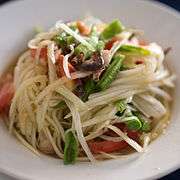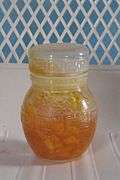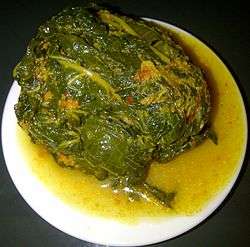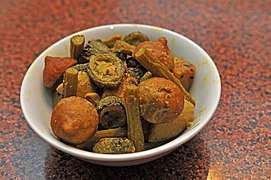Papaya
The papaya (/pəˈpaɪə/, US: /pəˈpɑːjə/) (from Carib via Spanish), papaw, (/pəˈpɔː/[2]) or pawpaw (/ˈpɔːpɔː/[2])[3] is the plant Carica papaya, one of the 22 accepted species in the genus Carica of the family Caricaceae.[4] Its origin is in the tropics of the Americas, perhaps from Central America and southern Mexico.[5]
| Papaya | |
|---|---|
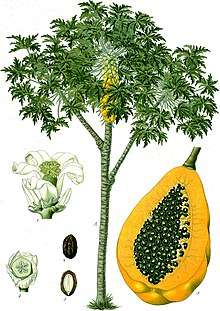 | |
| Papaya plant and fruit, from Koehler's Medicinal-Plants (1887) | |
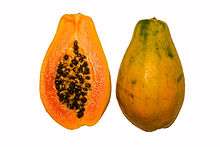 | |
| Papaya cross section showing orange flesh and numerous black seeds | |
| Scientific classification | |
| Kingdom: | Plantae |
| Clade: | Tracheophytes |
| Clade: | Angiosperms |
| Clade: | Eudicots |
| Clade: | Rosids |
| Order: | Brassicales |
| Family: | Caricaceae |
| Genus: | Carica |
| Species: | C. papaya |
| Binomial name | |
| Carica papaya | |
Description
The papaya is a small, sparsely branched tree, usually with a single stem growing from 5 to 10 m (16 to 33 ft) tall, with spirally arranged leaves confined to the top of the trunk. The lower trunk is conspicuously scarred where leaves and fruit were borne. The leaves are large, 50–70 cm (20–28 in) in diameter, deeply palmately lobed, with seven lobes. All parts of the plant contain latex in articulated laticifers.[6] Papayas are dioecious. The flowers are five-parted and highly dimorphic; the male flowers have the stamens fused to the petals. The female flowers have a superior ovary and five contorted petals loosely connected at the base.[7]:235 Male and female flowers are borne in the leaf axils, and the males are multiflowered dichasia, and the female flowers are in few-flowered dichasia. The pollen grains are elongated and approximately 35 microns in length. The flowers are sweet-scented, open at night, and wind- or insect-pollinated.[6][8][9]
The fruit is a large berry that is generally spherical or cylinder in form and about 15–45 cm (5.9–17.7 in) long and 10–30 cm (3.9–11.8 in) in diameter.[6]:88 It is ripe when it feels soft (as soft as a ripe avocado or softer), its skin has attained an amber to orange hue and along the walls of the large central cavity are attached numerous black seeds.[10]
| NCBI genome ID | 513 |
|---|---|
| Ploidy | diploid |
| Genome size | 372 million bp |
| Number of chromosomes | 36 |
| Year of completion | 2014 |
Origin and distribution
Native to Mexico and northern South America,[1][5][6] papaya has become naturalized throughout the Caribbean Islands, Florida, Texas, California, Hawaii, and other tropical and subtropical regions of the world.[1][8]
Cultivation
Papaya plants grow in three sexes: male, female, and hermaphrodite. The male produces only pollen, never fruit. The female produces small, inedible fruits unless pollinated. The hermaphrodite can self-pollinate since its flowers contain both male stamens and female ovaries. Almost all commercial papaya orchards contain only hermaphrodites.[9]
Originally from southern Mexico (particularly Chiapas and Veracruz), Central America, and northern South America,[5] the papaya is now cultivated in most tropical countries. In cultivation, it grows rapidly, fruiting within 3 years. It is, however, highly frost-sensitive, limiting its production to tropical climates. Temperatures below −2 °C (29 °F) are greatly harmful if not fatal. In Florida, California, and Texas, growth is generally limited to southern parts of those states. It prefers sandy, well-drained soil, as standing water can kill the plant within 24 hours.[11]
Production
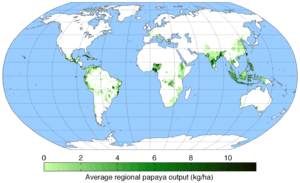
In 2018, global production of papayas was 13.3 million tonnes, led by India with 45% of the world total (table). Global papaya production grew significantly over the early 21st century, mainly as a result of increased production in India and demand by the United States.[12]
| Papaya production – 2018 | |
|---|---|
| Country | (millions of tonnes) |
Cultivars
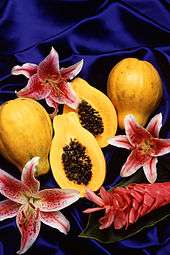
Two kinds of papayas are commonly grown. One has sweet, red or orange flesh, and the other has yellow flesh; in Australia, these are called "red papaya" and "yellow papaw", respectively.[14] Either kind, picked green, is called a "green papaya".
The large-fruited, red-fleshed 'Maradol', 'Sunrise', and 'Caribbean Red' papayas often sold in U.S. markets are commonly grown in Mexico and Belize.[5][15]
In 2011, Philippine researchers reported that by hybridizing papaya with Vasconcellea quercifolia, they had developed conventionally bred, nongenetically engineered papaya resistant to papaya ringspot virus (PRV).[16]
Genetically engineered cultivars
Carica papaya was the first transgenic fruit tree to have its genome sequenced.[17] In response to the papaya ringspot virus outbreak in Hawaii, in 1998, genetically altered papaya were approved and brought to market (including 'SunUp' and 'Rainbow' varieties.) Varieties resistant to PRV have some DNA of this virus incorporated into the DNA of the plant.[18][19] As of 2010, 80% of Hawaiian papaya plants were genetically modified. The modifications were made by University of Hawaii scientists, who made the modified seeds available to farmers without charge.[20][21]
Diseases and pests
Viruses
Papaya ringspot virus is a well-known virus within plants in Florida.[5] The first signs of the virus are yellowing and vein-clearing of younger leaves, as well as mottling yellow leaves. Infected leaves may obtain blisters, roughen, or narrow, with blades sticking upwards from the middle of the leaves. The petioles and stems may develop dark green greasy streaks and in time become shorter. The ringspots are circular, C-shaped markings that are a darker green than the fruit. In the later stages of the virus, the markings may become gray and crusty. Viral infections impact growth and reduce the fruit's quality. One of the biggest effects that viral infections have on papaya is the taste. As of 2010, the only way to protect papaya from this virus is genetic modification.[22]
The papaya mosaic virus destroys the plant until only a small tuft of leaves are left. The virus affects both the leaves of the plant and the fruit. Leaves show thin, irregular, dark-green lines around the borders and clear areas around the veins. The more severely affected leaves are irregular and linear in shape. The virus can infect the fruit at any stage of its maturity. Fruits as young as two weeks old have been spotted with dark-green ringspots about 1 inch (25 mm) in diameter. Rings on the fruit are most likely seen on either the stem end or the blossom end. In the early stages of the ringspots, the rings tend to be many closed circles, but as the disease develops, the rings increase in diameter consisting of one large ring. The difference between the ringspot and the mosaic viruses is the ripe fruit in the ringspot has mottling of colors and mosaic does not.[23]
Fungi
The fungus anthracnose is known to specifically attack papaya, especially the mature fruits. The disease starts out small with very few signs, such as water-soaked spots on ripening fruits. The spots become sunken, turn brown or black, and may get bigger. In some of the older spots, the fungus may produce pink spores. The fruit ends up being soft and having an off flavor because the fungus grows into the fruit.[24]
The fungus powdery mildew occurs as a superficial white presence on the surface of the leaf in which it is easily recognized. Tiny, light yellow spots begin on the lower surfaces of the leaf as the disease starts to make its way. The spots enlarge and white powdery growth appears on the leaves. The infection usually appears at the upper leaf surface as white fungal growth. Powdery mildew is not as severe as other diseases.[25]
The fungus phytophthora blight causes damping-off, root rot, stem rot, stem girdling, and fruit rot. Damping-off happens in young plants by wilting and death. The spots on established plants start out as white, water-soaked lesions at the fruit and branch scars. These spots enlarge and eventually cause death. The most dangerous feature of the disease is the infection of the fruit, which may be toxic to consumers.[24] The roots can also be severely and rapidly infected, causing the plant to brown and wilt away, collapsing within days.
Pests
The papaya fruit fly lays its eggs inside of the fruit, possibly up to 100 or more eggs.[5] The eggs usually hatch within 12 days when they begin to feed on seeds and interior parts of the fruit. When the larvae mature usually 16 days after being hatched, they eat their way out of the fruit, drop to the ground, and pupate in the soil to emerge within one to two weeks later as mature flies. The infected papaya turns yellow and drops to the ground after infestation by the papaya fruit fly.[24]
The two-spotted spider mite is a 0.5-mm-long brown or orange-red or a green, greenish-yellow translucent oval pest. They all have needle-like piercing-sucking mouthparts and feed by piercing the plant tissue with their mouthparts, usually on the underside of the plant. The spider mites spin fine threads of webbing on the host plant, and when they remove the sap, the mesophyll tissue collapses and a small chlorotic spot forms at the feeding sites. The leaves of the papaya fruit turn yellow, gray, or bronze. If the spider mites are not controlled, they can cause the death of the fruit.[24]
The papaya whitefly lays yellow, oval eggs that appear dusted on the undersides of the leaves. They eat papaya leaves, therefore damaging the fruit. There, the eggs developed into flies in three stages called instars. The first instar has well-developed legs and is the only mobile immature life stage. The crawlers insert their mouthparts in the lower surfaces of the leaf when they find it suitable and usually do not move again in this stage. The next instars are flattened, oval, and scale-like. In the final stage, the pupal whiteflies are more convex, with large, conspicuously red eyes.[24]
Papayas are one of the most common hosts for fruit flies like A. suspensa, which lay their eggs in overripe or spoiled papayas. The larvae of these flies then consume the fruit to gain nutrients until they can proceed into the pupal stage. This parasitism has led to extensive economic costs for nations in Central America.[26]
Culinary uses
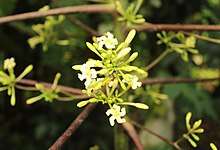
The unripe green fruit can be eaten cooked, but not raw due to its poisonous latex content. The ripe fruit of the papaya is usually eaten raw, without skin or seeds.[5] The black seeds of the papaya are edible and have a sharp, spicy taste.[5]
Southeast Asia
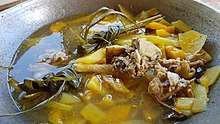
Green papaya is used in Southeast Asian cooking, both raw and cooked. In some parts of Asia, the young leaves of the papaya are steamed and eaten like spinach.
Papayas became a part of Filipino cuisine after being introduced to the islands via the Manila galleons.[27][28] Unripe or nearly ripe papayas (with orange flesh but still hard and green) are julienned and are commonly pickled into atchara, which is ubiquitous as a side dish to salty dishes.[29] Nearly ripe papayas can also be eaten fresh as ensaladang papaya (papaya salad) or cubed, and eaten dipped in vinegar or salt. Green papaya is also a common ingredient or filling in various savory dishes such as okoy, tinola, ginataan, lumpia, and empanada, especially in the cuisines of northern Luzon.[30][31][32]
In Indonesian cuisine, the unripe green fruits and young leaves are boiled for use as part of lalab salad, while the flower buds are sautéed and stir-fried with chillies and green tomatoes as Minahasan papaya flower vegetable dish.
In Lao and Thai cuisine, unripe green papayas are used to make a type of spicy salad known in Laos as tam maak hoong and in Thailand as som tam. It is also used in Thai curries, such as kaeng som.
South America
In Brazil, the unripe fruits are often used to make sweets or preserves.
Papain
Both green papaya fruit and its latex are rich in papain,[5] a protease used for tenderizing meat and other proteins, as practiced currently by indigenous Americans, people of the Caribbean region, and the Philippines.[5] It is now included as a component in some powdered meat tenderizers.[5] Papaya is not suitable for gelatin-based desserts because the enzymatic properties of papain prevent gelatin from setting.[33]
Nutrition
| Nutritional value per 100 g (3.5 oz) | |
|---|---|
| Energy | 179 kJ (43 kcal) |
10.82 g | |
| Sugars | 7.82 g |
| Dietary fiber | 1.7 g |
0.26 g | |
0.47 g | |
| Vitamins | Quantity %DV† |
| Vitamin A equiv. | 6% 47 μg3% 274 μg89 μg |
| Thiamine (B1) | 2% 0.023 mg |
| Riboflavin (B2) | 2% 0.027 mg |
| Niacin (B3) | 2% 0.357 mg |
| Pantothenic acid (B5) | 4% 0.191 mg |
| Folate (B9) | 10% 38 μg |
| Vitamin C | 75% 62 mg |
| Vitamin E | 2% 0.3 mg |
| Vitamin K | 2% 2.6 μg |
| Minerals | Quantity %DV† |
| Calcium | 2% 20 mg |
| Iron | 2% 0.25 mg |
| Magnesium | 6% 21 mg |
| Manganese | 2% 0.04 mg |
| Phosphorus | 1% 10 mg |
| Potassium | 4% 182 mg |
| Sodium | 1% 8 mg |
| Zinc | 1% 0.08 mg |
| Other constituents | Quantity |
| Water | 88 g |
| Lycopene | 1828 µg |
| |
| †Percentages are roughly approximated using US recommendations for adults. Source: USDA Nutrient Database | |
Raw papaya pulp contains 88% water, 11% carbohydrates, and negligible fat and protein (table). In a 100-g amount, papaya fruit provides 43 kilocalories and is a significant source of vitamin C (75% of the Daily Value, DV) and a moderate source of folate (10% DV), but otherwise has low content of nutrients (see table).
Phytochemicals
Papaya skin, pulp, and seeds contain a variety of phytochemicals, including carotenoids and polyphenols,[34] as well as benzyl isothiocyanates and benzyl glucosinates, with skin and pulp levels that increase during ripening.[35] Papaya seeds also contain the cyanogenic substance prunasin.[36]
Traditional medicine
In traditional medicine, papaya leaves have been used as a treatment for malaria,[37] an abortifacient, a purgative, or smoked to relieve asthma.[5]
Allergies and side effects
Papaya releases a latex fluid when not ripe, possibly causing irritation and an allergic reaction in some people. Because the enzyme papain acts as an allergen in sensitive individuals,[38] meat that has been tenderized with it may induce an allergic reaction.[5]
Gallery
 Seedlings
Seedlings Some 3-week-old papaya seedlings
Some 3-week-old papaya seedlings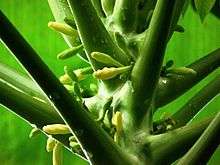 Buds
Buds- Female flowers
 Male flowers
Male flowers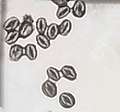 Pollen grains
Pollen grains Papaya flower
Papaya flower Leaf
Leaf Mature tree with unripe fruit in Kinshasa
Mature tree with unripe fruit in Kinshasa Unripe fruit
Unripe fruit- Ripe fruit
 Octastichous phyllotaxy of papaya leaves
Octastichous phyllotaxy of papaya leaves Papaya juice
Papaya juice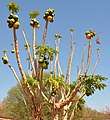 Papaya trees, always sparsely branched in South Africa
Papaya trees, always sparsely branched in South Africa
See also
References
- "Carica papaya L." U.S. National Plant Germplasm System. 9 May 2011. Retrieved 5 September 2017.
- "Papaw". Collins Dictionary. n.d. Retrieved 2014-09-25.
- In North America, papaw or pawpaw usually means the plant belonging to the Annonaceae family or its fruit. Ref.: Merriam-Webster's Collegiate Dictionary (2009), published in United States.
- "Carica". 2013.
- Morton JF (1987). "Papaya". NewCROP, the New Crop Resource Online Program, Center for New Crops & Plant Products, Purdue University; from p. 336–346. In: Fruits of warm climates, JF Morton, Miami, FL. Retrieved 23 May 2015.
- Heywood, VH; Brummitt, RK; Culham, A; Seberg, O (2007). Flowering plant families of the world. Firefly Books. ISBN 9781554072064.
- Ronse De Craene, L.P. (2010). Floral diagrams: an aid to understanding flower morphology and evolution. Cambridge: Cambridge University Press. ISBN 978-0-521-49346-8.
- "Papayas" (PDF). University of California at Davis. 2016. Retrieved 10 September 2017.
- C. L. Chia and Richard M. Manshardt (2001). "Why Some Papaya Plants Fail to Fruit" (PDF). Department of Tropical Plant and Soil Sciences. Retrieved 1 April 2015.CS1 maint: uses authors parameter (link)
- "papaya | Description, Cultivation, Uses, & Facts". Encyclopedia Britannica. Retrieved 2020-07-28.
- Boning, Charles R. (2006). Florida's Best Fruiting Plants: Native and Exotic Trees, Shrubs, and Vines. Sarasota, Florida: Pineapple Press, Inc. pp. 166–167.
- "An Overview of Global Papaya Production, Trade, and Consumption". Electronic Data Information Source, University of Florida. Retrieved 2014-02-07.
- "Papaya production in 2018; Crops/Regions/World list/Production Quantity (pick lists)". UN Food and Agriculture Organization, Corporate Statistical Database (FAOSTAT). 2019. Retrieved 28 February 2020.
- "Papaya Varieties". Papaya Australia. 2015. Retrieved 9 December 2015.
- Sagon, Candy (13 October 2004). "Maradol Papaya". Market Watch (13 Oct 2004). The Washington Post. Retrieved 21 July 2011.
- Siar, S. V.; Beligan, G. A.; Sajise, A. J. C.; Villegas, V. N.; Drew, R. A. (2011). "Euphytica, Volume 181, Number 2". Euphytica. SpringerLink. 181 (2): 159–168. doi:10.1007/s10681-011-0388-z.
- Borrell. "Papaya genome project bears fruit". ugr.es.
- "Genetically Altered Papayas Save the Harvest". mhhe.com.
- "Hawaiipapaya.com". Hawaiipapaya.com. Archived from the original on 2015-01-07. Retrieved 2013-06-15.
- Ronald, Pamela and McWilliams, James (14 May 2010) Genetically Engineered Distortions The New York Times, accessed 1 October 2012
- Archived March 31, 2012, at the Wayback Machine
- Gonsalves, D., S. Tripathi, J. B. Carr, and J. Y. Suzuki (2010). "Papaya ringspot virus".CS1 maint: uses authors parameter (link)
- Hine, B.R.; Holtsmann, O.V.; Raabe, R.D. (July 1965). "Disease of papaya in Hawaii" (PDF).
- Mossler, M.A.; Crane, J. (2008). "Florida crop/pest management profile: papaya" (PDF). University of Florida. Archived from the original (PDF) on 30 June 2017.
- Cunningham, B. & Nelson, S. (2012, June). "Powdery mildew of papaya in Hawaii" (PDF).CS1 maint: uses authors parameter (link)
- Sivinski, J.M.; Calkins, C.O.; Baranowski, R.; Harris, D.; Brambila, J.; Diaz, J.; Burns, R.E.; Holler, T.; Dodson, G. (April 1996). "Suppression of a Caribbean Fruit Fly (Anastrepha suspensa(Loew) Diptera: Tephritidae) Population through Augmented Releases of the ParasitoidDiachasmimorpha longicaudata(Ashmead) (Hymenoptera: Braconidae)". Biological Control. 6 (2): 177–185. doi:10.1006/bcon.1996.0022. ISSN 1049-9644.
- Alonso, Nestor, II (15 September 2009). "First Taste Of Mexican Cuisine". PhilStar Global. Retrieved 15 December 2018.
- "Champorado and the Manila Galleon Trade". Ariana Eats Lumpia. Retrieved 15 December 2018.
- "Achara". SBS TV. Retrieved 15 December 2018.
- "The green papaya in Filipino cuisine". Glossary of Filipino Food ...and essays on the world's "original fusion cuisine" too. Retrieved 15 December 2018.
- "What to eat in Philippines?". FoodYouShouldTry.com. Retrieved 15 December 2018.
- "Green Papaya Recipe". Vegetarian Yums. Retrieved 15 December 2018.
- Donna Pierce (2006-01-18). "Papaya". The Chicago Tribune. Retrieved 2020-06-04.
- Rivera-Pastrana DM, Yahia EM, González-Aguilar GA (2010). "Phenolic and carotenoid profiles of papaya fruit (Carica papaya L.) and their contents under low temperature storage". J Sci Food Agric. 90 (14): 2358–65. doi:10.1002/jsfa.4092. PMID 20632382.CS1 maint: uses authors parameter (link)
- Rossetto MR, Oliveira do Nascimento JR, Purgatto E, Fabi JP, Lajolo FM, Cordenunsi BR (2008). "Benzylglucosinolate, benzylisothiocyanate, and myrosinase activity in papaya fruit during development and ripening". J Agric Food Chem. 56 (20): 9592–9. doi:10.1021/jf801934x. PMID 18826320.
- Seigler DS, Pauli GF, Nahrstedt A, Leen R (2002). "Cyanogenic allosides and glucosides from Passiflora edulis and Carica papaya". Phytochemistry. 60 (8): 873–82. doi:10.1016/s0031-9422(02)00170-x. PMID 12150815.
- Titanji, V.P.; Zofou, D.; Ngemenya, M.N. (2008). "The Antimalarial Potential of Medicinal Plants Used for the Treatment of Malaria in Cameroonian Folk Medicine". African Journal of Traditional, Complementary and Alternative Medicines. 5 (3): 302–321. PMC 2816552. PMID 20161952.
- "Papain". National Library of Medicine, US National Institutes of Health. 27 April 2019. Retrieved 29 April 2019.
External links
| Look up papaya or papaw in Wiktionary, the free dictionary. |
| Wikibooks Cookbook has a recipe/module on |
| Wikimedia Commons has media related to: |
_-_Philippines.jpg)
